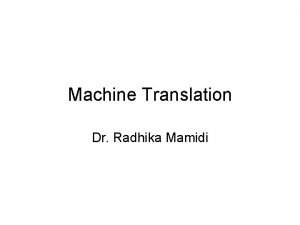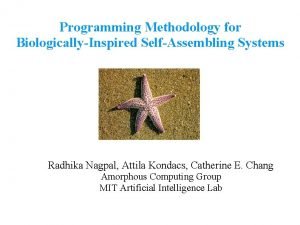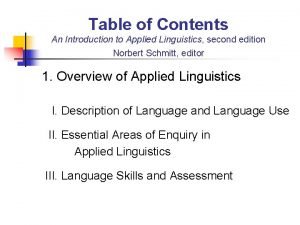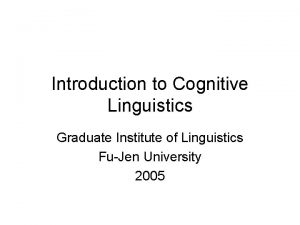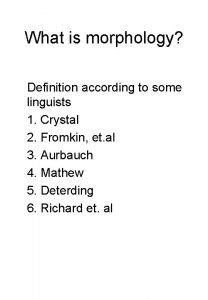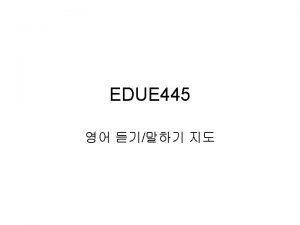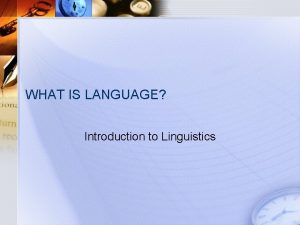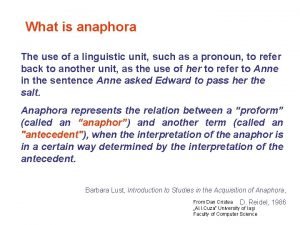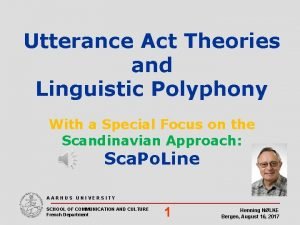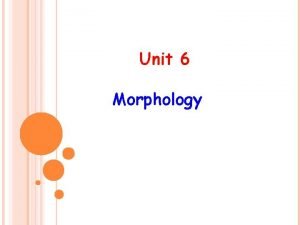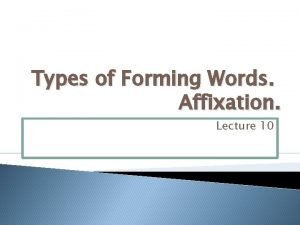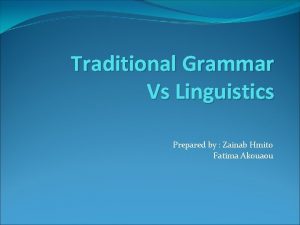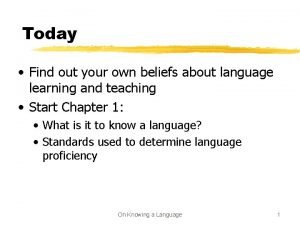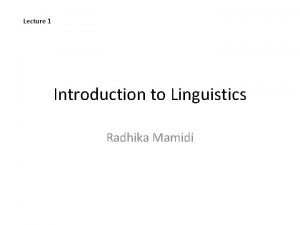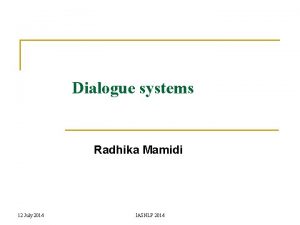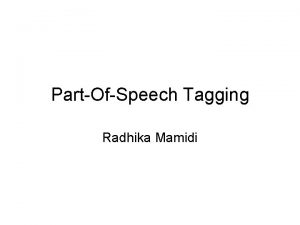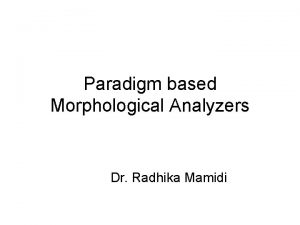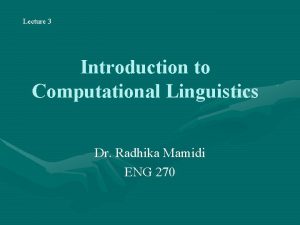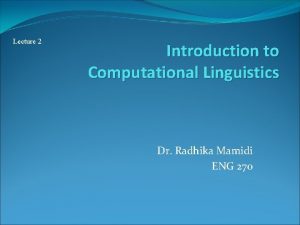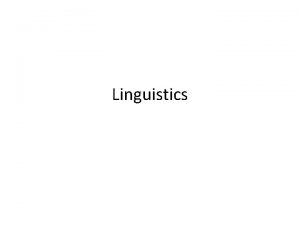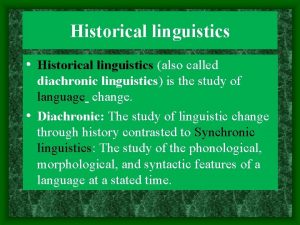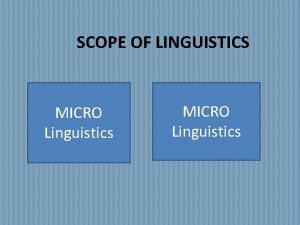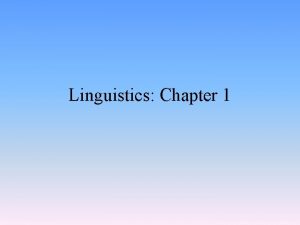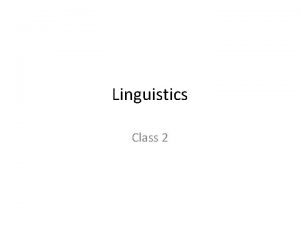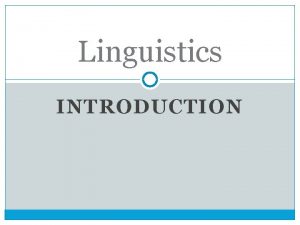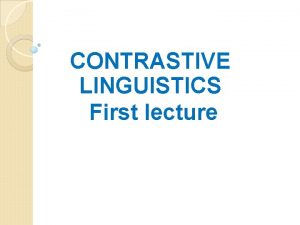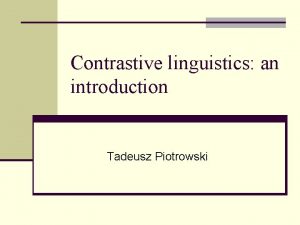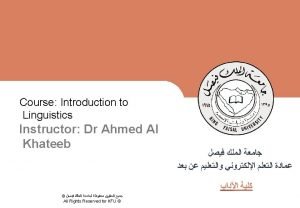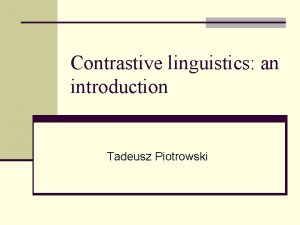Lecture 3 Introduction to Linguistics 3 Radhika Mamidi























- Slides: 23

Lecture 3 Introduction to Linguistics - 3 Radhika Mamidi

Levels of Language Processing • • • Phonology Morphology Syntax Semantics Pragmatics Discourse Analysis

What are the kinds of knowledge needed for language processing? Boy : Say something soft and sweet. Girl: Custard pudding. Boy (offering sweets): Sweets for the sweet. Girl: Here, have some nuts. Johnnie: Mom! I am going out to play. Mom: With those holes in your socks!! Johnnie: No, with the kids next door.

Memory General Knowledge Lexicon INPUTS Lexical Processing Syntactic Rules Semantic Rules Syntactic Processing Discourse Rules Semantic Processing Discourse Processing Model of Language Processing To derive meaning you need all kinds of rules – ‘building’, ‘blocks’ Eg: The building blocks are made of plastic. The building blocks the sun. OUTPUTS

Human language is complex teach – taught *preach - praught he-his-him *she-shis-shim ring – rang - rung *bring – brang - brung slim chance = fat chance ? slim girl = fat girl Consistency? Regularity?

Human language is ambiguous Ambiguity at different language levels: Pronounce “GHOTI” [one spelling – different sounds] I scream/ice-cream, a nameless man/an aimless man He showed me the mouse - rodent/object The leopard was spotted - verb/adjective She hit the boy with the umbrella I am reading a book on films - [now-a-days/right now] Mary promised Sally(i) to go to her(i) party Mary(i) persuaded Sally to go to her(i) party

Pragmatic Analysis • Grice’s Conversational Implicatures • Speech Act Theory • Politeness principles Think if it is easy to make the computers understand the pragmatics of language!

Grice’s theory of implicatures • Proposed by H. P. Grice (1975) • A theory of how people use the language. • Guidelines for effective & efficient use of language in conversation. • Four Gricean Maxims – Quality, Quantity, Relevance and Manner – Together describe the general principle of co-operative interaction: “. . . make your contribution such as is required, at the stage at which it occurs, by the accepted purpose or direction of the talk exchange in which you are engaged. ” Violation of maxims Implicatures

In short. . . in order to converse in a maximally efficient, rational, cooperative way, the participants should speak sincerely, relevantly and clearly, while providing sufficient information. Counter-example 1 A: Is Ravi at home? B: He went to Hyderabad. Counter-example 2 A: Thanks for texting that you have reached home safely. B: I am very sorry. I intended to call you, but I became so busy…

Speech Act Theory • Speech Acts – Locutionary, Illocutionary, Perlocutionary Acts – Indirect Speech Acts

Speech Acts - illustration John to his cousin, Bill: “I am very thirsty. ” • Locutionary act: the utterance of a sentence with determinate sense and reference – Reference of ‘I’; Sense of ‘thirsty’ • Illocutionary act: the making of a statement, offer, promise, etc. in uttering a sentence, by virtue of the conventional force associated with it – Austin calls this act as SPEECH ACT – Here, it is an act of request (for water) • Perlocutionary act: the bringing about of effects on the audience by means of uttering the sentence, such effects being special to the circumstances of utterances – Bill brings John a glass of water.

Indirect Speech Acts • A class of utterances whose syntactic forms do not match their illocutionary force. • The implicature arises when the sincerity conditions are not met. • Examples: 1. Can you pass the salt? = ‘‘please pass the salt’’ 2. Will you clean your room today? = ‘‘clean your room today’’ 3. It’s cold in here. = ‘‘can you shut the windows’’ 4. You are standing on my foot. = ‘‘please move’’

Discourse • • • A paragraph A small joke A short story A novel A conversation • It has to be cohesive.

Local Discourse Context • Includes syntactic and semantic structures of preceding sentences. • Useful for: – detecting antecedents of pronouns – interpreting sentences with VP ellipsis

Cohesive devices • Co-reference relations – Anaphoric forms • Ellipsis • Cue Phrases • Discourse relations

Co-reference relations Co-referential forms cannot be interpreted semantically in their own right - they refer to something else for their interpretation. Exophora: The reference is outside the text. Eg. ‘Look at that’. that = Endophora: The reference is inside the text. Anaphoric: Look at the fish. It is blue. Cataphoric: It is blue, the fish.

Types of Anaphoric form (a) Repeated form: The Prime Minister met the cricketers. The Prime Minister wished them good luck. (b) Partially repeated form: Prof Ruslan Mitkov met the students. Prof. Mitkov had something nice to say to them. (c) Lexical Replacement: Mary’s daughter came first again. The child is good at studies. (d) Pronominal form: Zoha said she would have to take Noor to the doctor. (e) Substituted form: Mary has a birthday in May. Sue has one too. (f) Ellided form: Anne is in London. So is Kate. And Linda.

Let’s resolve the pronouns: • Ali slapped Sam. He was stunned. • Ali slapped Sam. He was scolded. • If the baby does not like the new toy, throw it away. • If the baby does not like the new toy, give it the old one. • John and Mary went to buy mangoes. They are very expensive. • John and Mary went to buy mangoes. They are very stingy.

Ellipsis • Syntactically incomplete sentences • Parts missing are retrieved from previous major clause. • Helen saw the movie. So did Mary. • Helen bought a new car. So did Mary. • A correspondence between the two subject forms exist.

Cue Phrases Two classes: (A) • identifies semantic relationships between clauses or states • used for continuation, reason, contrast, conclusion Jack went to the store. Sam stayed at home. (read with ‘and’, ‘because’, ‘but’, ‘so’ inserted between the sentence) (B) • indicates discourse structure (they indicate segment boundaries • used to end the current topic, to end the discourse, start digression OK/fine, Bye/thanks, By the way

Discourse relations a. Explanation b. Elaboration c. Narration d. Background e. Result f. Parallel

Find the correct relation between the sentences in each pair. (i) John teaches at PSU is a private university. (ii) John drove to college in his car. The traffic was very bad. (iii) John loves teaching Maths and Mary loves teaching Art. (iv) John took an extra hour of class. The students looked bored. (v) John looks sick. He has eaten the yellow stuff again. (vi) John went to college. He took his class.

Analyse this text at all the levels of language Father: Now, Junior, be good while I am away. Son: I will be good for a dollar. Father: At your age, I was good for nothing.
 Translate text from image
Translate text from image Chittibabu and chinnababu live in
Chittibabu and chinnababu live in Radhika nagpal
Radhika nagpal Traditional linguistics and modern linguistics
Traditional linguistics and modern linguistics Difference between linguistics and applied linguistics
Difference between linguistics and applied linguistics 01:640:244 lecture notes - lecture 15: plat, idah, farad
01:640:244 lecture notes - lecture 15: plat, idah, farad Summary of the study of language george yule
Summary of the study of language george yule Introduction to english linguistics exercises answers
Introduction to english linguistics exercises answers Applied linguistics
Applied linguistics Lexical category
Lexical category Introduction to biochemistry lecture notes
Introduction to biochemistry lecture notes Introduction to psychology lecture
Introduction to psychology lecture Introduction to algorithms lecture notes
Introduction to algorithms lecture notes Morphology definition linguistics examples
Morphology definition linguistics examples Linguistics as a science
Linguistics as a science Dialectology in linguistics
Dialectology in linguistics Double articulation
Double articulation Arbbitrary
Arbbitrary Anaphora and antecedent
Anaphora and antecedent Utterance definition linguistics
Utterance definition linguistics A morpheme has two elements
A morpheme has two elements Wat is een afleiding
Wat is een afleiding Advantages of traditional grammar
Advantages of traditional grammar Grammatical competence
Grammatical competence
